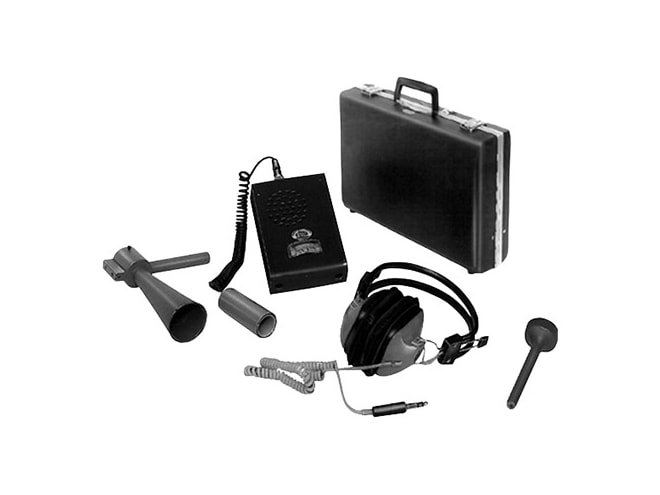
Megger 569001 Ultrasonic Leak & Corona Detector
Portable system designed for locating gas leaks and electrical corona sources via air-borne ultrasonic signals.

- 569001-KIT
- By Megger
Overview
Features
- Compact long-distance directional pickup
- Amplifies 35 to 45kHz frequencies
- Converts to audible sounds
- Displays output visibly and audibly
- Insensitive to high ambient audible noise levels
- Solid-state circuitry designed for high reliability
- Runs on one 9V transistor battery
- Battery life is approximately 75 hours
What's in the Box
- Hand-held transducer probe with retractable cable
- Directional horn with peep sight and pistol-grip handle
- Sound concentrator
- 8-ohm headset
- Foam protected case
Description
The Megger 569001 ultrasonic leak and corona detector receives air-borne ultrasonic frequencies that are inaudible to the unaided human ear and converts them to an audible range. It amplifies them and displays the output visibly on a meter and audibly through a speaker or headset. Variously shaped collectors facilitate quick location of the ultrasonic sources. The directional pickup horn allows pinpointing of discharges in high-voltage equipment while the operator remains at a safe distance form the source.
With the transducer probe plugged into the instrument, the operator can immediately locate many ultrasonic sources by scanning with the transducer probe held as a flashlight and using the speaker or meter to detect maximum emissions. For greater sensitivity, or to further pinpoint a distant source, the operator simply slips the directional horn over the transducer. The focus is now greatly concentrated, permitting source location to within a 1ft (0.3m) circle at 30ft (9m). If the source can be approached, the rubber sound concentrator is slipped over the transducer probe, pinpointing a source to within its tip diameter of about 0.5in (13mm).
Leak Detection
Where gas or air leaks produce a turbulence that creates sonic energy, the ultrasonic detector can detect a 0.002in (0.05mm) diameter leak at 5ft (1.5m) with only 10psi pressure. The instrument can also be used to detect leaks in vacuum systems, and to detect leakage of poisonous, noxious, explosive or expensive gases in gas pressure systems.
Corona Detection
The ultrasonic detector is most useful for locating corona sources that are exposed directly to the surrounding air, such as on terminations, high-voltage bus systems, bushings and transformers. The detector is excellent for patrolling pole lines and checking all kinds of electrical equipment for leaky insulators and faulty connections. It is also used in research and development work for locating points of excessive stress on small electrical components and assemblies, as well as on very large equipment. The detector is ideal for finding and cleaning up corona discharge points on the high-voltage test floor. When used for locating corona discharge, all suitable safety precautions must be taken to avoid electric shock.
Need Help? Call a Temperature engineer at 1-800-884-4967
We're open Mo-Th 8am to 5:30pm. Fr 8am to 5pm ET






